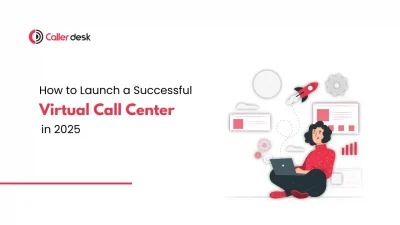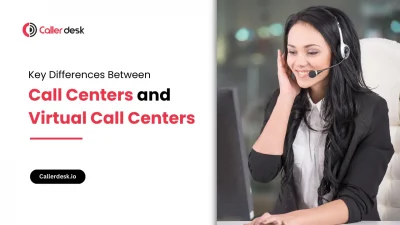Are you still using an office-based call center to talk to your customers? If yes, you may be spending more money and effort than necessary.
Today, many smart businesses use something better a Virtual Contact Center. This modern system helps companies handle customer calls without setting up a big office or buying expensive equipment.
This new way of working helps teams save money, reply faster, work comfortably, and give better service to customers.
In this blog, we’ll explain what a Virtual Contact Center is, how it works, and why more businesses are switching to it.
What is a Virtual Contact Center?
A Virtual Contact Center (VCC) is a modern way for businesses to talk to their customers without needing a big office. In this system, customer service agents can handle phone calls, emails, chats, and messages using the internet from anywhere like from home or even another city.
Instead of sitting in one place, agents can:
- Work from home or any remote location
- Use special call center software on a computer or laptop
- Talk to customers and solve problems online
It works just like a regular call center, but everything happens on a computer. This setup is simple, flexible, and a smart choice for startups, small teams, or growing businesses that want to save money and grow faster.
How Do Virtual Contact Centers Work?
A Virtual Contact Centers uses cloud-based technology to manage customer interactions. Here’s a detailed breakdown of how the system typically works from start to finish:
Step 1: Customer Reaches Out
Customers contact your business through:
- Phone call (toll-free number or IVR-enabled number)
- WhatsApp, Facebook, website chat, or email
These calls or messages don’t go through normal phone lines. Instead, they’re managed online using cloud-based phone systems.
Step 2: Smart Call Routing
When a call or message comes in, the software decides where to send it. It checks:
- Which agents are available
- Customer’s past interactions (if your system is connected to a CRM)
- Language or type of problem (for skill-based routing)
- If the customer can solve it using automated IVR menus
If no one is free, it can offer self-help or schedule a callback.
Step 3: Agent Handles the Call
The selected agent receives the call or message on their virtual dashboard, which they can access through a laptop, mobile, or desktop. The agent interface typically shows:
- Caller details (name, number, location)
- Past communication history and notes from previous interactions
- CRM data such as recent complaints, tickets, or account status
The agent answers the call using VoIP (Voice over Internet Protocol), allowing high-quality internet-based communication without a SIM card or landline. During the call, the agent can:
- Answer the query or issue
- Transfer the call to another team
- Take real-time notes in the CRM
- Schedule a follow-up call if needed
Step 4: Live Monitoring
To ensure high service standards, supervisors can monitor ongoing activity through an admin dashboard. Key quality control features include:
- Live call monitoring: Supervisors can listen in on calls without interrupting the conversation.
- Call recording: All calls are recorded for compliance, quality checks, and future training.
- Speech analytics: AI tools can analyze the conversation to detect customer sentiment, keywords, or compliance breaches.
- Barge-in capability: Supervisors can join a call if the situation needs escalation or live support.
This ensures that agents stay on track and maintain service quality even while working remotely.
Step 5: After-Call Actions
Once the call ends, the system automatically triggers several post-call processes:
- CRM is updated with call notes, status, and resolution.
- Automated follow-up messages (SMS or email) are sent to the customer for confirmation, thank you, or additional information.
- Feedback collection: A quick survey may be sent to collect customer feedback.
- Ticket creation: If the issue requires further attention, a helpdesk ticket is automatically generated and assigned to a senior or specialized agent.
All of this happens in real time keeping your customer service flow efficient, organized, and trackable.
Key Features of Virtual Contact Center Software
1. Cloud-Based Setup
Forget big servers and messy wiring.
With cloud-based software, you can:
- Log in from any browser (laptop or mobile)
- Start taking calls instantly no setup delay
- Keep your data safe with automatic cloud backups
- Scale your team in minutes, not months
It’s cost-effective, fast, and lets you work from anywhere even if your team is spread across cities or countries.
2. VoIP Calling
VoIP (Voice over Internet Protocol) is the backbone of a virtual Contact center.
Here’s why it’s better:
- Lower call costs than traditional phone systems
- No SIM cards or landlines needed
- High-quality voice calls, even on low-speed internet
- Call from your laptop or mobile with one click
With VoIP, you’re not tied to a desk. Calls happen over the internet – fast, flexible, and affordable.
3. Multi-Channel Support
Modern customers don’t just call – they text, email, WhatsApp, and use live chat.
Your software should combine it all:
- Manage calls, emails, SMS, WhatsApp, and chat from one dashboard
- Handle customer support on any platform without switching tabs
- Keep conversation history in one place for context
Omnichannel support means more convenience for your customers and more efficiency for your team.
4. CRM Integration
When your software is connected to a CRM (Customer Relationship Management), agents get instant context.
- View past orders, complaints, and call history
- Greet the caller by name
- Avoid asking the same questions again
- Solve issues faster with full customer background
CRM-connected call centers offer personalized support, which leads to happier and more loyal customers.
5. Real-Time Monitoring
Want to know how your agents are performing without micromanaging?
With live dashboards, supervisors can:
- Monitor live calls and agent activity
- Track call status in real time
- Barge into calls if escalation is needed
- Whisper tips to agents during calls (customer won’t hear it)
You can coach, correct, or step in instantly keeping quality under control at all times.
6. Call Analytics and Performance Reports
Good software gives you more than just call logs. It gives you insights.
- Average handling time – how long are calls taking
- First-call resolution – are issues solved on the first attempt
- Agent performance – who’s doing well and who needs support
- Customer satisfaction – feedback from call surveys and reviews
These metrics help you continuously improve your support quality, agent training, and overall customer experience.
5 Major Benefits of Virtual Contact Centers
1. Cost Efficiency
A virtual contact center eliminates major expenses like:
- Office rent, electricity, and maintenance costs.
- Expensive IT infrastructure (everything runs on cloud-based software).
- Additional hardware (agents only need a laptop and headset).
2. Flexibility
With a virtual contact center, businesses can:
- Hire agents globally to provide 24/7 customer support.
- Adjust staffing based on demand (increase or reduce agents easily).
- Allow employees to work remotely, improving their job satisfaction.
A business serving international customers can assign agents from different time zones to ensure round-the-clock support.
3. Increased Productivity
Remote work in a virtual contact center solution helps employees:
- Avoid long commutes, saving time and energy.
- Work in a stress-free environment, leading to better focus.
- Maintain a better work-life balance, keeping them happy.
4. Higher Customer Satisfaction
A virtual contact center helps businesses provide:
- Faster response times (calls are routed to the right agent instantly).
- Personalized service (CRM integration helps agents understand customer needs).
- 24/7 availability (customers get support anytime they need it).
For Example: A customer needing urgent help at midnight can still get assistance through a virtual contactcenter service.
5. Lower Employee Turnover
A virtual contact center makes employees feel valued, leading to:
- Higher job satisfaction (flexibility and comfort).
- Less burnout (fewer stressful office conditions).
- Stronger employee loyalty (fewer agents quitting their jobs).
Lower turnover means less time and money spent on hiring and training new employees.
Types of Virtual Contact Centers
1. Virtual Inbound Call Centers
A virtual inbound call center focuses on managing incoming customer calls. These calls can be related to support, complaints, order processing, or technical assistance.
Businesses that prioritize customer service and retention, such as:
- E-commerce platforms (order tracking & returns).
- IT support teams (helpdesk & troubleshooting).
- Service providers (banking, healthcare, telecom).
Key Features:
- Customer support for queries & complaints.
- Technical helpdesk for troubleshooting.
- Order processing & tracking.
2. Virtual Outbound Call Centers
A virtual outbound call center specializes in outgoing calls to customers or leads for sales, follow-ups, surveys, and appointment reminders. These centers are commonly used for:
- Retail & e-commerce (customer feedback & re-engagement).
- Financial services (payment reminders & loan offers).
- Healthcare (appointment scheduling & follow-ups).
Key Features:
- Following up on leads or past interactions.
- Telemarketing campaigns to promote products or services.
- Conducting surveys for customer feedback.
3. Blended Call Centers
A blended virtual call center combines inbound and outbound services, allowing agents to handle customer inquiries and make proactive calls when needed. This setup provides maximum flexibility and efficiency for businesses.
Businesses that require both support and outreach, such as:
- Retail & e-commerce (handling orders & promotions).
- Healthcare providers (patient inquiries & follow-up calls).
- B2B service companies (customer support & lead nurturing).
Key Features:
- Adaptability to changing business needs.
- Agents can switch between inbound & outbound calls.
- Better resource utilization & cost efficiency.
Why Choose CallerDesk for Your Virtual Contact Center?
If you’re looking for virtual contact center software that is powerful, easy to use, and built for Indian businesses, CallerDesk is a smart choice. Here’s why:
1. Cloud-Based Platform
CallerDesk works entirely through the cloud.
This means:
- You don’t need to buy or install any servers.
- Agents can work from anywhere with an internet connection.
- You can manage your call center operations through a simple online dashboard.
It’s fast to set up and easy to scale as your team grows.
2. Made for Indian Businesses
CallerDesk is designed with Indian companies in mind.
You get:
- Indian customer support that understands your needs.
- Pricing in INR, with plans suited for startups and enterprises.
- Full compliance with Indian telecom rules and licenses.
No confusing global pricing. No support delays. Just smooth local service
3. Built-In Integrations for WhatsApp, CRM, and IVR
CallerDesk connects with the tools your team already uses.
With built-in integrations, you can:
- Chat with customers directly via WhatsApp.
- Access customer history and data using your CRM during calls.
- Set up IVR menus to route calls to the right agents automatically.
This saves time, reduces manual work, and improves customer service.
4. Real-Time Dashboards and Call Recording
CallerDesk gives you full visibility into your operations.
With real-time dashboards and reporting tools, you can:
- Monitor live call status, agent performance, and queue volume.
- Listen to recorded calls for quality checks and training.
- Use data to improve customer support and agent productivity.
You always know what’s happening, even with a remote team.
5. Quick Setup and Instant Onboarding
You don’t need to wait days or weeks to get started.
CallerDesk is ready to go in just 15 minutes:
- No coding or technical setup required.
- Agents can log in and start receiving calls immediately.
- Works on desktops, laptops, or mobile devices.
This is ideal for fast-moving teams that can’t afford delays.
6. Flexible Pricing with No Setup Cost
CallerDesk follows a pay-as-you-use model, so you only pay for what you need.
There are:
- No hidden charges
- No setup or installation fees
- No need to commit to long-term contracts
You can start small, test the platform, and scale up as needed.
Conclusion
A virtual contact center is a smart and cost-effective way for businesses to manage customer service. With VoIP technology and cloud-based software, companies can provide flexible, efficient, and scalable customer support while reducing costs.
Why Businesses Are Choosing Virtual Contact Centers:
- Lower costs – No need for office space, utilities, or IT maintenance.
- More flexibility – Hire agents from anywhere and scale as needed.
- Higher productivity – Remote agents work in a comfortable, focused environment.
- Better customer service – Faster responses and 24/7 support improve customer satisfaction.
- Happier employees – Remote work reduces stress and improves work-life balance.
If you’re looking for a powerful virtual contact center solution, try CallerDesk!
Book a free demo today to see how CallerDesk’s cloud-based call center software can help you improve customer service, reduce costs, and scale your operations effortlessly.



